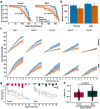Repetitive mild head trauma induces activity mediated lifelong brain deficits in a novel Drosophila model
- PMID: 33958652
- PMCID: PMC8102574
- DOI: 10.1038/s41598-021-89121-7
Repetitive mild head trauma induces activity mediated lifelong brain deficits in a novel Drosophila model
Abstract
Mild head trauma, including concussion, can lead to chronic brain dysfunction and degeneration but the underlying mechanisms remain poorly understood. Here, we developed a novel head impact system to investigate the long-term effects of mild head trauma on brain structure and function, as well as the underlying mechanisms in Drosophila melanogaster. We find that Drosophila subjected to repetitive head impacts develop long-term deficits, including impaired startle-induced climbing, progressive brain degeneration, and shortened lifespan, all of which are substantially exacerbated in female flies. Interestingly, head impacts elicit an elevation in neuronal activity and its acute suppression abrogates the detrimental effects in female flies. Together, our findings validate Drosophila as a suitable model system for investigating the long-term effects of mild head trauma, suggest an increased vulnerability to brain injury in female flies, and indicate that early altered neuronal excitability may be a key mechanism linking mild brain trauma to chronic degeneration.
Conflict of interest statement
The authors declare no competing interests.
Figures






Similar articles
-
Drosophila melanogaster as a model to study age and sex differences in brain injury and neurodegeneration after mild head trauma.Front Neurosci. 2023 Apr 3;17:1150694. doi: 10.3389/fnins.2023.1150694. eCollection 2023. Front Neurosci. 2023. PMID: 37077318 Free PMC article. Review.
-
Mild traumatic brain injury in Drosophila melanogaster alters reactive oxygen and nitrogen species in a sex-dependent manner.Exp Neurol. 2024 Feb;372:114621. doi: 10.1016/j.expneurol.2023.114621. Epub 2023 Nov 27. Exp Neurol. 2024. PMID: 38029809 Free PMC article.
-
Mild head injury increasing the brain's vulnerability to a second concussive impact.J Neurosurg. 2001 Nov;95(5):859-70. doi: 10.3171/jns.2001.95.5.0859. J Neurosurg. 2001. PMID: 11702878
-
Resonance of human brain under head acceleration.J R Soc Interface. 2015 Jul 6;12(108):20150331. doi: 10.1098/rsif.2015.0331. J R Soc Interface. 2015. PMID: 26063824 Free PMC article.
-
Head injury and dementia.Curr Opin Neurol. 2004 Dec;17(6):719-23. doi: 10.1097/00019052-200412000-00012. Curr Opin Neurol. 2004. PMID: 15542981 Review.
Cited by
-
Dietary restriction ameliorates TBI-induced phenotypes in Drosophila melanogaster.Sci Rep. 2022 Jun 9;12(1):9523. doi: 10.1038/s41598-022-13128-x. Sci Rep. 2022. PMID: 35681073 Free PMC article.
-
Drosophila melanogaster as a model to study age and sex differences in brain injury and neurodegeneration after mild head trauma.Front Neurosci. 2023 Apr 3;17:1150694. doi: 10.3389/fnins.2023.1150694. eCollection 2023. Front Neurosci. 2023. PMID: 37077318 Free PMC article. Review.
-
dTBI2: A Calibrated, Tunable Device for Administering Traumatic Brain Injury in Drosophila.Curr Protoc. 2024 Mar;4(3):e996. doi: 10.1002/cpz1.996. Curr Protoc. 2024. PMID: 38511393 Free PMC article.
-
Arsenic impairs Drosophila neural stem cell mitotic progression and sleep behavior in a tauopathy model.bioRxiv [Preprint]. 2024 Aug 7:2024.08.05.606375. doi: 10.1101/2024.08.05.606375. bioRxiv. 2024. Update in: G3 (Bethesda). 2025 May 8;15(5):jkaf049. doi: 10.1093/g3journal/jkaf049. PMID: 39149321 Free PMC article. Updated. Preprint.
-
Mild traumatic brain injury in Drosophila melanogaster alters reactive oxygen and nitrogen species in a sex-dependent manner.Exp Neurol. 2024 Feb;372:114621. doi: 10.1016/j.expneurol.2023.114621. Epub 2023 Nov 27. Exp Neurol. 2024. PMID: 38029809 Free PMC article.
References
-
- Little DM, Geary EK, Moynihan M, Alexander A, Pennington M, Glang P, Schulze ET, Dretsch M, Pacifico A, Davis ML, Stevens AB, Huang JH. Imaging chronic traumatic brain injury as a risk factor for neurodegeneration. Alzheimers Dement. 2014;10(3 Suppl):S188–S195. - PubMed
Publication types
MeSH terms
Grants and funding
LinkOut - more resources
Full Text Sources
Other Literature Sources
Medical
Molecular Biology Databases

